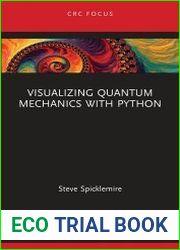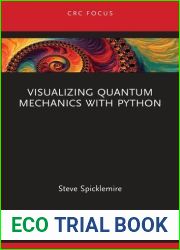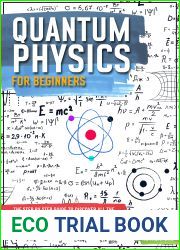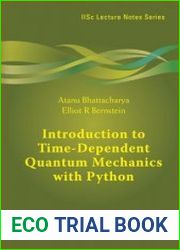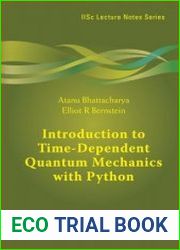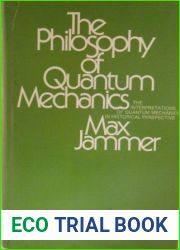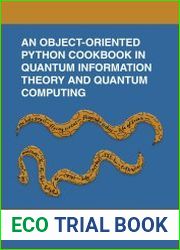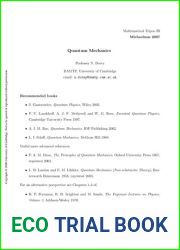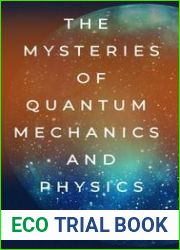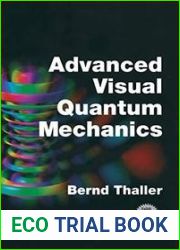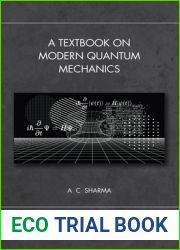
BOOKS - Visualizing Quantum Mechanics with Python

Visualizing Quantum Mechanics with Python
Author: Stephen Spicklemire
Year: 2024
Format: PDF
File size: 10.1 MB
Language: ENG

Year: 2024
Format: PDF
File size: 10.1 MB
Language: ENG

Book Description: Visualizing Quantum Mechanics with Python Quantum Mechanics can be an abstract and complex subject, leaving students often complaining of confusion, struggle, and frustration as they try to master the topic. However, the goal of this book is to reduce the complexity and clarify the abstractions with concrete visual examples driven by simple Python programs. It is assumed that the reader is concurrently taking a course in quantum mechanics or self-studying quantum mechanics but is looking for supplementary material to help with understanding and visualizing how quantum mechanics works. The focus of this book is writing Python programs to visualize the underlying behavior of the mathematical theory. Background Needed: To understand quantum mechanics, one needs a strong foundation in differential equations and linear algebra because the behavior of quantum systems is governed by equations written in terms of these concepts. Modern physics includes concepts such as special relativity and quantum phenomena like the photoelectric effect and energy quantization that the theory of quantum mechanics seeks to explain. This book is not an introduction to the Python programming language or NumPy or even VPython; however, its programming examples start simply and grow more complex as the chapters progress, so deep expertise in any of these is not a prerequisite.
Визуализация квантовой механики с помощью Python Quantum Mechanics может быть абстрактным и сложным предметом, оставляя студентов часто жаловаться на растерянность, борьбу и разочарование, когда они пытаются освоить эту тему. Однако цель этой книги - снизить сложность и уточнить абстракции на конкретных визуальных примерах, управляемых простыми Python-программами. Предполагается, что читатель одновременно проходит курс квантовой механики или самообучения квантовой механики, но ищет дополнительный материал, который поможет понять и визуализировать, как работает квантовая механика. Основное внимание в этой книге уделяется написанию программ на языке Python для визуализации основного поведения математической теории. Для понимания квантовой механики необходима прочная основа в дифференциальных уравнениях и линейной алгебре, потому что поведение квантовых систем регулируется уравнениями, написанными в терминах этих понятий. Современная физика включает такие понятия, как специальная теория относительности и квантовые явления вроде фотоэффекта и квантования энергии, которые стремится объяснить теория квантовой механики. Эта книга не является введением в язык программирования Python или NumPy или даже VPython; однако его примеры программирования начинаются просто и усложняются по мере развития глав, поэтому глубокие знания в любой из них не являются обязательным условием.
Visualiser la mécanique quantique avec Python Quantum Mechanics peut être un sujet abstrait et complexe, laissant les étudiants se plaindre souvent de la confusion, de la lutte et de la frustration quand ils essaient de maîtriser le sujet. Cependant, le but de ce livre est de réduire la complexité et de clarifier les abstractions sur des exemples visuels spécifiques gérés par de simples programmes Python. lecteur est supposé suivre simultanément un cours de mécanique quantique ou d'auto-apprentissage de la mécanique quantique, mais à la recherche d'un matériel supplémentaire qui aidera à comprendre et à visualiser le fonctionnement de la mécanique quantique. Ce livre se concentre sur l'écriture de programmes en Python pour visualiser le comportement de base de la théorie mathématique. Pour comprendre la mécanique quantique, il faut une base solide dans les équations différentielles et l'algèbre linéaire, car le comportement des systèmes quantiques est régi par des équations écrites en termes de ces concepts. La physique moderne comprend des concepts tels que la théorie spéciale de la relativité et des phénomènes quantiques comme l'effet photographique et la quantification de l'énergie, que la théorie de la mécanique quantique cherche à expliquer. Ce livre n'est pas une introduction au langage de programmation Python ou NumPy ou même VPython ; cependant, ses exemples de programmation commencent simplement et se compliquent à mesure que les chapitres évoluent, de sorte que la connaissance approfondie dans l'un d'entre eux n'est pas une condition préalable.
Visualizar la mecánica cuántica con Python Quantum Mechanics puede ser un tema abstracto y complejo, dejando a los estudiantes a menudo quejándose de confusión, lucha y frustración cuando intentan dominar el tema. n embargo, el objetivo de este libro es reducir la complejidad y aclarar las abstracciones en ejemplos visuales específicos administrados por simples programas Python. Se supone que el lector toma simultáneamente un curso de mecánica cuántica o autoaprendizaje de mecánica cuántica, pero busca material adicional que ayude a entender y visualizar cómo funciona la mecánica cuántica. Este libro se centra en la escritura de programas en lenguaje Python para visualizar el comportamiento básico de la teoría matemática. Para entender la mecánica cuántica es necesaria una base sólida en ecuaciones diferenciales y álgebra lineal, porque el comportamiento de los sistemas cuánticos está regulado por ecuaciones escritas en términos de estos conceptos. La física moderna incluye conceptos como la teoría especial de la relatividad y fenómenos cuánticos como el efecto fotográfico y la cuantización de la energía, que la teoría de la mecánica cuántica busca explicar. Este libro no es una introducción al lenguaje de programación Python o NumPy o incluso VPython; sin embargo, sus ejemplos de programación comienzan de manera sencilla y se complican a medida que se desarrollan los capítulos, por lo que un conocimiento profundo en cualquiera de ellos no es un requisito previo.
Die Visualisierung der Quantenmechanik mit Python Quantum Mechanics kann ein abstraktes und komplexes Thema sein und lässt die Schüler oft über Verwirrung, Kampf und Frustration klagen, wenn sie versuchen, das Thema zu meistern. Ziel dieses Buches ist es jedoch, die Komplexität zu reduzieren und Abstraktionen an konkreten visuellen Beispielen zu verfeinern, die von einfachen Python-Programmen gesteuert werden. Es wird davon ausgegangen, dass der ser gleichzeitig einen Kurs in Quantenmechanik oder ein Selbststudium in Quantenmechanik absolviert, aber nach zusätzlichem Material sucht, um zu verstehen und zu visualisieren, wie Quantenmechanik funktioniert. Der Schwerpunkt dieses Buches liegt auf dem Schreiben von Programmen in Python, um das grundlegende Verhalten der mathematischen Theorie zu visualisieren. Für das Verständnis der Quantenmechanik ist eine solide Grundlage in Differentialgleichungen und linearer Algebra erforderlich, da das Verhalten von Quantensystemen durch Gleichungen reguliert wird, die in Bezug auf diese Konzepte geschrieben sind. Die moderne Physik umfasst Konzepte wie die spezielle Relativitätstheorie und Quantenphänomene wie den photoelektrischen Effekt und die Quantisierung von Energie, die die Theorie der Quantenmechanik zu erklären sucht. Dieses Buch ist keine Einführung in die Programmiersprache Python oder NumPy oder sogar VPython; Seine Programmierbeispiele beginnen jedoch einfach und werden mit der Entwicklung von Kapiteln komplizierter, so dass ein tiefes Wissen in einem von ihnen keine Voraussetzung ist.
''
Kuantum mekaniğini Python Kuantum Mekaniği ile görselleştirmek soyut ve karmaşık bir konu olabilir, bu da öğrencilerin konuya hakim olmaya çalışırken sık sık karışıklık, mücadele ve hayal kırıklığından şikayet etmelerine neden olur. Bununla birlikte, bu kitabın amacı karmaşıklığı azaltmak ve basit Python programları tarafından kontrol edilen belirli görsel örnekler üzerindeki soyutlamaları iyileştirmektir. Okuyucunun aynı anda bir kuantum mekaniği veya kuantum mekaniğinin kendi kendine incelenmesi sürecinden geçtiği, ancak kuantum mekaniğinin nasıl çalıştığını anlamaya ve görselleştirmeye yardımcı olacak ek materyaller aradığı varsayılmaktadır. Bu kitap, matematiksel teorinin temel davranışını görselleştirmek için Python'da programlar yazmaya odaklanmaktadır. Kuantum mekaniğini anlamak, diferansiyel denklemlerde ve doğrusal cebirde sağlam bir temel gerektirir, çünkü kuantum sistemlerinin davranışı bu kavramlar açısından yazılmış denklemler tarafından yönetilir. Modern fizik, özel görelilik ve kuantum mekaniği teorisinin açıklamaya çalıştığı fotoefekt ve enerji kuantizasyonu gibi kuantum fenomenleri gibi kavramları içerir. Bu kitap Python veya NumPy programlama diline, hatta VPython'a giriş değildir; Bununla birlikte, programlama örnekleri basit bir şekilde başlar ve bölümler geliştikçe daha karmaşık hale gelir, bu nedenle hiçbirinde derinlemesine bilgi bir önkoşul değildir.
يمكن أن يكون تصور ميكانيكا الكم باستخدام ميكانيكا بايثون الكمومية موضوعًا مجردًا ومعقدًا، مما يترك الطلاب يشكون كثيرًا من الارتباك والصراع والإحباط أثناء محاولتهم إتقان الموضوع. ومع ذلك، فإن الهدف من هذا الكتاب هو تقليل التعقيد وصقل التجريدات على أمثلة بصرية محددة تتحكم فيها برامج بايثون البسيطة. من المفترض أن القارئ يخضع في نفس الوقت لدورة من ميكانيكا الكم أو الدراسة الذاتية لميكانيكا الكم، لكنه يبحث عن مادة إضافية من شأنها أن تساعد في فهم وتصور كيفية عمل ميكانيكا الكم. يركز هذا الكتاب على كتابة البرامج في بايثون لتصور السلوك الأساسي للنظرية الرياضية. يتطلب فهم ميكانيكا الكم أساسًا صلبًا في المعادلات التفاضلية والجبر الخطي لأن سلوك الأنظمة الكمومية تحكمه معادلات مكتوبة من حيث هذه المفاهيم. تتضمن الفيزياء الحديثة مفاهيم مثل النسبية الخاصة والظواهر الكمومية مثل التأثير الضوئي وتكميم الطاقة، والتي تسعى نظرية ميكانيكا الكم إلى تفسيرها. هذا الكتاب ليس مقدمة للغة البرمجة Python أو NumPy، أو حتى VPython ؛ ومع ذلك، تبدأ أمثلة البرمجة ببساطة وتصبح أكثر تعقيدًا مع تطور الفصول، لذا فإن المعرفة المتعمقة في أي منها ليست شرطًا أساسيًا.







